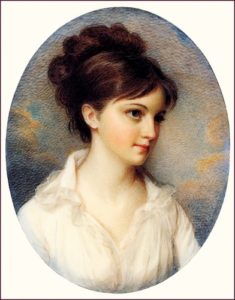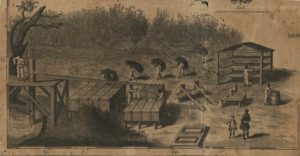
Brilliant Businesswoman
She was a 16 year old girl running her family’s plantation all by herself while they lived 1000 miles away. Her dad mailed her indigo seeds from his Caribbean farm and challenged her to see if they could grow in a more northern climate. She used her knowledge, creativity, and a bit of luck to run experiments on how to make the indigo thrive. Her persistence created a new cash crop that was a significant part of South Carolina’s economy for years. Step back to 1744 and meet Eliza Lucas Pinckney…
Her Ruby Shoe Moment
The Power of the Wand
Her Yellow Brick Road
Brains, Heart & Courage
Glinda’s Gallery
Just the Facts
Her Ruby Shoe Moment
Eliza had butterflies in her stomach as she handed over her sample of indigo dye. It was 1744 and Eliza was sending a cake of her indigo dye to London to be tested for quality and price. All her hopes and dreams were in that package. And five long years of hard work.
Even though she was only 16 years old, Eliza was determined to make her father’s plantations in South Carolina successful. Her goal was to diversify the crops grown at the Lucas plantations and pay off her family’s debt.
 At the time, indigo was very expensive. It was the best blue dye for fabric and in high demand within England’s textile industry. Most of the indigo was imported from either French or Spanish territories in the Caribbean. But then, England found itself at war with France and could no longer import indigo from the French West Indies. So it needed a new source, preferably within the British Empire. Eliza decided to give it a try.
At the time, indigo was very expensive. It was the best blue dye for fabric and in high demand within England’s textile industry. Most of the indigo was imported from either French or Spanish territories in the Caribbean. But then, England found itself at war with France and could no longer import indigo from the French West Indies. So it needed a new source, preferably within the British Empire. Eliza decided to give it a try.
Indigo was a tropical plant. But Eliza was determined to figure out how to make it work in South Carolina. Luckily, Eliza loved botany. And her dad supported her efforts — he sent her indigo seed packets from Antigua regularly. Eliza kept experimenting until she cultivated an indigo plant that could withstand the South Carolina winter.
Growing a variety of indigo plant that would flourish in South Carolina was only half the battle, however. Eliza had to learn the expensive and complex process of extracting the dye from the indigo plant. But she didn’t do it alone. Her father hired an indigo expert to help Eliza. And the reality of plantation life was that enslaved people did all the work.
 Eliza had to keep herself busy while waiting for the indigo test results from England. Finally, in December of 1744, she received a letter that confirmed the high quality of her indigo — “I have shown your indigo to one of our most noted Brokers in that way, who tried it against some of the best French, and in his opinion it is as good.” The letter went on to say that Parliament would give South Carolina a competitive edge over the French when it supplied enough indigo dye to meet British demand. She did it!
Eliza had to keep herself busy while waiting for the indigo test results from England. Finally, in December of 1744, she received a letter that confirmed the high quality of her indigo — “I have shown your indigo to one of our most noted Brokers in that way, who tried it against some of the best French, and in his opinion it is as good.” The letter went on to say that Parliament would give South Carolina a competitive edge over the French when it supplied enough indigo dye to meet British demand. She did it!
Her next step was to get her neighbors to see the wisdom of her idea. Eliza distributed her indigo seeds to plantation owners throughout South Carolina. She also shared information about planting and dye making techniques in South Carolina newspapers, so all could benefit from her experience. Within a few years, South Carolina planters produced all the indigo that England could need. And a new cash crop was born.
South Carolina’s agriculture changed forever. And it wasn’t all positive. Indigo production was labor intensive and didn’t work financially without the institution of slavery. Plantations that grew indigo relied heavily upon enslaved labor. Every indigo cake was tainted with slavery.
The Power of the Wand
Indigo was a big part of the South Carolina Colony’s economy for over 30 years. By the time of the American Revolution, indigo comprised one-third of the total value of all exports from South Carolina Colony (second only to rice) — one million pounds of indigo cakes annually.
Eliza’s legacy of independence and determination lives on through generations of America’s businesswomen. And the fashion industry wouldn’t be what it is today without the coveted indigo dye (blue jeans come to mind). Today, teens like Isabella Rose Taylor are making their own mark on fashion. At age 9, Isabella started making clothes inspired by “colors, shapes, poetry, travel and the beauty of everything around me.” And she designed them specifically for tweens. By the time Isabella was 12, she released her first collection at Austin Fashion Week and won the Rising Star Award. “I think the keys to success are blood, sweat and glitter.”
Her Yellow Brick Road
Eliza was only 16 years old when she found herself in charge of the family business in South Carolina — she had to take care of her younger sister, manage 5,000 acres on three plantations, and pay off the family’s debts.
Eliza was convinced that the key to their financial problems was crop diversification. She thought it was risky to grow only rice and hoped to find another crop to complement their rice fields. So she experimented with a number of different crops— ginger, fig trees, flax, cotton, silk, alfalfa, cassava root, and hemp. But none gave her the crop she was looking for.

Illustration of the Indigo Plant (Charleston Magazine)
Then, Eliza asked her father to send some indigo seeds from Antigua. And she experimented with the seeds after they arrived. Eliza had to figure out when to plant the crop, how much water it needs, and what soil works best. It was tough at first — some crops died in the frost, others were eaten by bugs.
Indigo production was a big gamble for Eliza. The start-up costs were high, since the process required a lot of equipment. And the process involved just as much art as science. In fact, there were men called “dye-makers,” who were experts in processing the indigo plants and extracting the dye.
Eliza’s father hired a dye-maker to help Eliza get started and teach her the process. Nicholas Cromwell traveled from Montserrat, a British island in the Caribbean. He “helped” her for 3 years, but in reality caused as much harm as good. He thought the dye-making industry on Montserrat would suffer if the American Colonies grew indigo as well. So he built the vats from brick, which gave the dye a reddish color. And he sabotaged a batch of dye on purpose. Eventually, Nicholas returned home and his brother, Patrick, arrived to help Eliza. He actually taught her what she needed to know to be successful.
The indigo plants had to be harvested at the perfect time to achieve the most vivid and rich color. Once the harvest began, it was a race against time to get the indigo processed into dye. The work was intense and all-consuming for a few weeks — it had to be monitored 24 hours per day. If anything went wrong, the dye would be ruined. It was a tricky process and there were many pitfalls along the way.

1773 Illustration of Indigo Dye Making Operations (Charleston County Public Library)
On harvest day, the plants were submerged into the “steeper” — the largest wooden vat filled with warm water. As the leaves fermented, they released blue bubbles into the water. And the whole thing began to stink.
At just the right time, the blue liquid was drained into the second wooden vat, the “battery.” Then, it was stirred vigorously to oxygenate the dye particles. This continued, day and night, until it was thick. Then, lime was added to separate the dye particles from the water (lime was a mixture of crushed oyster shells and water).
Eventually, the dye settled to the bottom of the vat and created a paste, which was scooped into the third vat. The paste was kneaded until smooth, pressed into shallow moulds, cut into 2×2 inch cakes, and placed in a drying house (a roof but no walls). Once completely dry, the cakes were packed into barrels and shipped to the market.
Eliza’s first batch of dye in 1741 wasn’t very good. But she kept at it and learned from every failure. Finally, with Patrick’s help, she produced 17 pounds of dye cakes in 1744. She dyed some fabric and thought it was a good batch. But she needed the experts in London to agree.
Brains, Heart & Courage
Eliza grew up on the island of Antiqua, which was part of the British West Indies in the Caribbean. Her father, George, was a Lieutenant Colonel in the British Army and served in the colonial government. Their family was part of the elite plantation society and owned one of the best estates on Antigua. They owned about 200 enslaved people, who kept the plantation running.
During her childhood, Eliza developed a lifelong love of gardening and plants. And she was interested in everything that grew on their plantation, called “Cabbage Tree.” She also learned how to grow and process sugar cane and how to plant vegetables in the kitchen garden. And her life was governed by the rhythms and cycles of sugar production and farm life.
 Eliza had a very close relationship with her father. They were very similar — they both loved books, valued education, and constantly looked for ways to improve things around them. He encouraged Eliza to try new things, be inquisitive, resourceful, and take chances.
Eliza had a very close relationship with her father. They were very similar — they both loved books, valued education, and constantly looked for ways to improve things around them. He encouraged Eliza to try new things, be inquisitive, resourceful, and take chances.
Even though the family lived on Antigua, London was the center of their world — they sold their sugar to London and bought all their personal goods from London. When she was ten years old, Eliza attended boarding school in London. She was there for five years, studying French, music, and botany. It was fairly unusual for the time for girls to be as highly educated as Eliza.
Eliza’s father had inherited three tracts of land near Charleston, South Carolina. The land provided the Lucas family with items needed in Antigua, such as timber and food for their slaves. In 1738, the family moved to South Carolina to escape the tensions between England and Spain that were brewing in the Caribbean. They settled on the Wapoo Plantation and hired managers for the other two plantations.
One year later, her dad was appointed Lt. Governor of Antigua. So, he returned to the Caribbean and left Eliza in charge of the plantations. He gave her a lot of responsibility. And she was up for the challenge.
Glinda’s Gallery
Just the Facts
- Eliza Lucas was born on December 28, 1722 on the island of Antigua. She had two brothers (Thomas and George) and a younger sister, Mary (Polly). The was the third generation of the Lucas family to grow up on Antigua.
- Eliza rejected two suitors arranged by her father, which was completely unheard of at the time. Then, she married a close family friend, Charles Pinckney, on May 25, 1744 (he was 23 years older than she and a recent widow).
- The rest of her family returned to Antigua after Eliza’s wedding.
- Eliza and Charles had five children — Charles, George, Thomas and Harriott (George died as an infant).
- The Pinckney family lived in London for about 5 years, while their children attended school and Charles represented the interests of South Carolina’s governor in trade matters. Charles died of malaria upon their return to South Carolina.
- Their sons played big parts in the founding of our country — they both served in the Continental Army and fought in the Revolutionary War. And they were both successful lawyers. Charles signed the United States Constitution (as a representative of South Carolina) and George was an ambassador to Spain.
- Eliza lost everything during the Revolutionary War — the British looted her home, burnt her fields, and freed her slaves.
- Eliza died in Philadelphia from breast cancer in 1793 (she had traveled there for medical treatment). George Washington requested to be a pallbearer at her funeral, which was held the very next day.
- Eliza was the first woman to be inducted into South Carolina’s Business Hall of Fame in 1989.
Want to Know More?
Feeser, Andrea. Red, White and Black Make Blue: Indigo in the Fabric of Colonial South Carolina Life. Athens: University of Georgia Press, 2013.
Pinckney, Elise. The Letter Book of Eliza Pinckney. Columbia: University of South Carolina Press, 1997 (reprint edition).
Pickett, Margaret. Eliza Lucas Pinckney: Colonial Plantation Manager and Mother of American Patriots, 1722-1793. New York: McFarland, 2016.
Ravenel, Harriet Horry. Eliza Pinckney. New York: Charles Scribner & Sons, 1896.
Williams, Frances. Plantation Patriot: A Biography of Eliza Pinckney. New York: Harcourt, Brace & World, 1967.
Winberry, John. “Indigo in South Carolina: A Historical Geography.” Southeastern Geographer, Vol. 19, No. 2 (November, 1979), pp. 91-102.
The Pinckney Papers Project. University of South Carolina, Department of History.
Eliza Lucas Pinckney Letters & Memoranda, 1740-1762, National Humanities Center Toolbox (http://nationalhumanitiescenter.org/pds/becomingamer/peoples/text5/elizapinckney.pdf)
